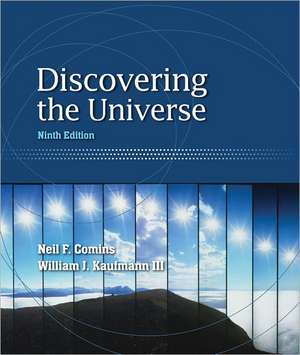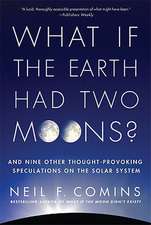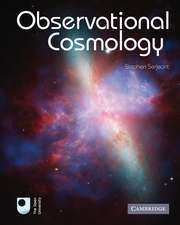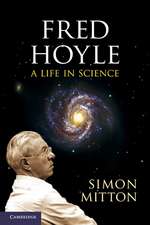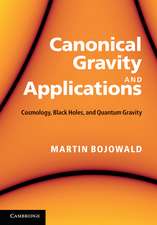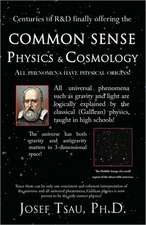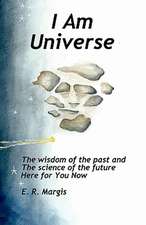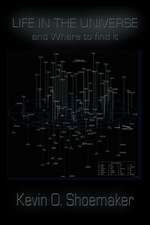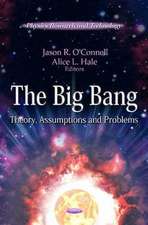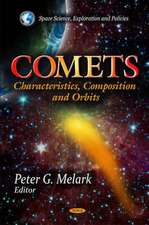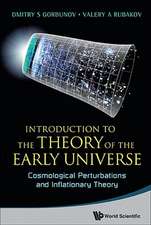Discovering the Universe
Autor Neil F. Comins, William J. Kaufmannen Limba Engleză Paperback – 28 ian 2013
Preț: 338.26 lei
Preț vechi: 380.07 lei
-11% Nou
Puncte Express: 507
Preț estimativ în valută:
64.73€ • 67.33$ • 53.44£
64.73€ • 67.33$ • 53.44£
Carte disponibilă
Livrare economică 27 martie-01 aprilie
Preluare comenzi: 021 569.72.76
Specificații
ISBN-13: 9781429255202
ISBN-10: 142925520X
Pagini: 544
Dimensiuni: 234 x 275 x 20 mm
Greutate: 1.35 kg
Ediția:Revizuită
Editura: W. H. Freeman
Colecția W. H. Freeman
Locul publicării:New York, United States
ISBN-10: 142925520X
Pagini: 544
Dimensiuni: 234 x 275 x 20 mm
Greutate: 1.35 kg
Ediția:Revizuită
Editura: W. H. Freeman
Colecția W. H. Freeman
Locul publicării:New York, United States
Cuprins
Preface
PART I: UNDERSTANDING ASTRONOMY
1. Discovering the Night Sky
2. Gravitation and the Motion of the Planets
3. Light and Telescopes
4. Atomic Physics and Spectra
PART II: UNDERSTANDING THE SOLAR SYSTEM
5. Formation of the Solar System and Other Planetary Systems
6. Earth and Moon
7. The Other Terrestrial Planets
8. The Outer Planets
9. Vagabonds of the Solar System
10. The Sun: Our Extraordinary Ordinary Star
PART III: UNDERSTANDING THE STARS
11. Characterizing Stars
12. The Lives of Stars from Birth Through Middle Age
13. The Deaths of Stars
14. Black Holes: Matters of Gravity
Part IV: UNDERSTANDING THE UNIVERSE
15. The Milky Way Galaxy
16. Galaxies
17. Quasars and Other Active Galaxies
18. Cosmology
19. Astrobiology Appendices
Appendices
Glossary
Answers to Margin Questions and Computational Questions
Index
PART I: UNDERSTANDING ASTRONOMY
1. Discovering the Night Sky
2. Gravitation and the Motion of the Planets
3. Light and Telescopes
4. Atomic Physics and Spectra
PART II: UNDERSTANDING THE SOLAR SYSTEM
5. Formation of the Solar System and Other Planetary Systems
6. Earth and Moon
7. The Other Terrestrial Planets
8. The Outer Planets
9. Vagabonds of the Solar System
10. The Sun: Our Extraordinary Ordinary Star
PART III: UNDERSTANDING THE STARS
11. Characterizing Stars
12. The Lives of Stars from Birth Through Middle Age
13. The Deaths of Stars
14. Black Holes: Matters of Gravity
Part IV: UNDERSTANDING THE UNIVERSE
15. The Milky Way Galaxy
16. Galaxies
17. Quasars and Other Active Galaxies
18. Cosmology
19. Astrobiology Appendices
Appendices
Glossary
Answers to Margin Questions and Computational Questions
Index
Notă biografică
Neil F. Comins is Professor of Physics and Astronomy at the University of Maine, Orono, USA.
William J. Kaufmann III, late of San Diego State University, USA.
William J. Kaufmann III, late of San Diego State University, USA.
Caracteristici
Clear and engaging writing style
Updated with current research from Scientific American and modern theories in solar system formation
Strong pedagogical features
Updated with current research from Scientific American and modern theories in solar system formation
Strong pedagogical features
Caracteristici noi
Margin questions in most sections of the book encourage students to test themselves about important concepts before errors accumulate. Answers to approximately one-third of these questions appear at the end of this text. Margin photos connect concepts to their applications in everyday life. For example, during the discussion of solar eclipses, a photo shows a student using a pinhole camera to view an eclipse. Margin charts show the sky location of important astronomical objects cited in the text, including details that allow students to locate the objects with either the unaided eye or a small telescope. New coverage of the planets is based on the new classification scheme for the objects in the solar system. The text reconciles the new definitions of planets, dwarf planets, and small solar system objects with existing classes of objects, including planets, moons, asteroids, meteoroids, and comets. Also explained is how Pluto fits more comfortably with the dwarf planets than with the eight planets.Expanding final chapter, Astrobiology, now offers a richer presentation of this emerging topic. New Summary figures appear throughout the book to show either the interactions between important concepts or the evolution of important objects.
